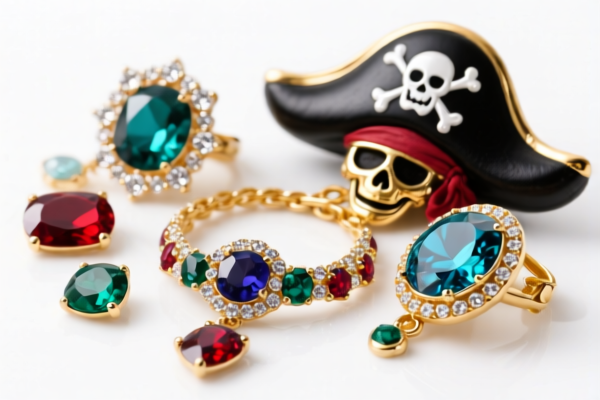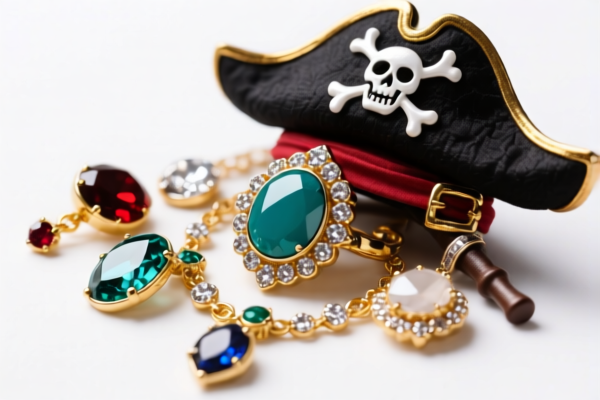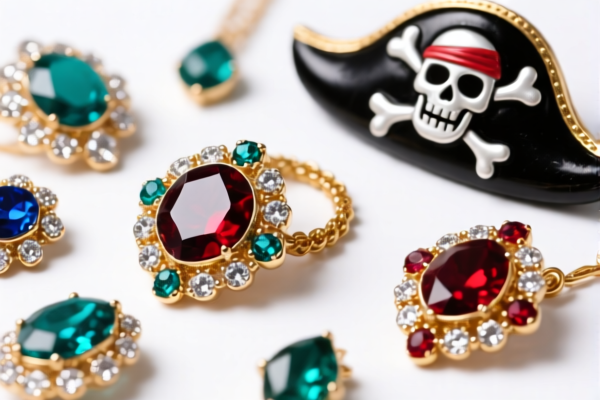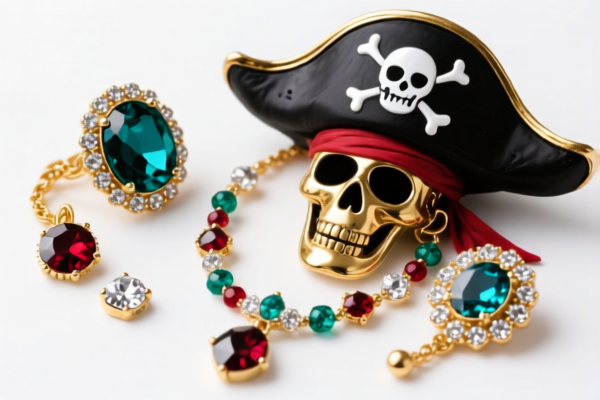Found 8 matching results
(CN → US)
| HS Code | Official Doc | Tariff Rate | Origin | Destination | Effective Date |
|---|---|---|---|---|---|
| 7113111000 | Doc | 43.8% | CN | US | 2025-05-12 |
| 7113195045 | Doc | 43.0% | CN | US | 2025-05-12 |
| 7117196000 | Doc | 37.5% | CN | US | 2025-05-12 |
| 7117904500 | Doc | 30.0% | CN | US | 2025-05-12 |
| 9601908000 | Doc | 41.2% | CN | US | 2025-05-12 |
| 9601902000 | Doc | 37.5% | CN | US | 2025-05-12 |
| 9620005000 | Doc | 60.3% | CN | US | 2025-05-12 |
| 9620006500 | Doc | 57.9% | CN | US | 2025-05-12 |




Pirate Jewels
Pirate jewels encompass a diverse collection of valuable adornments historically associated with pirates, often acquired through plunder and representing wealth, status, and sometimes, practical use.
Materials
The composition of pirate jewels varied widely, dependent on the targets raided and the pirates' preferences. Common materials included:
- Gold: Highly sought after, used in rings, necklaces, earrings, and as bullion.
- Silver: Another frequently looted precious metal, utilized for similar items as gold.
- Gemstones: Diamonds, rubies, emeralds, sapphires, pearls, and other precious and semi-precious stones were prized for their beauty and value. Pearls were particularly common, sourced from the Caribbean and Indian Ocean.
- Other Stones: Less valuable but still desirable stones like garnets, amethysts, and topazes were also incorporated into jewelry.
- Non-Precious Materials: Occasionally, pirates would incorporate materials like coral, ivory, and even polished shells into their adornments, often as a symbolic or decorative element.
Purpose & Function
- Wealth Display: Jewels served as a visible demonstration of a pirate’s success and standing within the crew. Larger, more elaborate pieces indicated greater plunder and influence.
- Trade & Currency: Jewels could be used as a form of currency in port towns, traded for supplies, bribes, or safe passage.
- Status Symbol: Specific types of jewels or styles might signify a pirate's role (captain, quartermaster, etc.) or affiliation with a particular pirate group.
- Practical Use (Limited): While less common, some jewels were believed to have protective qualities or were incorporated into navigational tools (e.g., gemstones used in astrolabes).
- Personal Adornment: Pirates, despite their rough reputation, often wore jewelry for aesthetic reasons.
Usage Scenarios
- Port Towns: Jewels were frequently exchanged in taverns, marketplaces, and with fences for goods, services, and information.
- Crew Distribution: Looted jewels were often divided amongst the pirate crew, with the captain and officers receiving larger shares.
- Bribes & Negotiation: Jewels could be used to bribe officials, secure safe passage, or negotiate ransoms.
- Personal Collections: Some pirates amassed personal collections of jewels, either to display their wealth or to hide as a form of long-term investment.
- Burial (Myth & Reality): The image of pirates burying treasure chests filled with jewels is largely a romanticized myth, though some pirates did conceal smaller caches of valuables.
Common Types
- Rings: Often signet rings (used for sealing documents) or rings adorned with gemstones.
- Necklaces & Pendants: Elaborate necklaces with multiple gemstones or pendants featuring symbolic designs.
- Earrings: Hoop earrings, drop earrings, and studs were common, often featuring gold, silver, and gemstones.
- Brooches & Pins: Used to fasten clothing and often decorated with gemstones or intricate designs.
- Buckles: Belt buckles and shoe buckles could be made of gold or silver and adorned with gemstones.
- Rosaries & Crosses: Often looted from Spanish ships, some pirates wore these as a form of ironic display or as a personal keepsake.
- Gemstone-Inlaid Swords & Daggers: While not strictly jewelry, swords and daggers with gemstone-inlaid hilts were a symbol of status and wealth.
Based on the provided information, “pirate jewels” can be interpreted as jewelry or imitation jewelry, potentially made from various materials. Here's a breakdown of relevant HS codes:
- 7113111000: This code covers articles of jewelry and parts thereof, specifically those made of precious metal (silver in this case). It includes rope, curb, cable, chain, and similar articles produced in continuous lengths, whether cut to specific lengths or set with imitation pearls or gemstones, suitable for use in manufacturing jewelry. The total tax rate is 43.8% (6.3% base tariff, 7.5% additional tariff, and 30.0% additional tariff after April 2, 2025).
- 7117196000: This code covers imitation jewelry made of base metal, whether or not plated with precious metal. It specifically refers to “Other” types, including toy jewelry valued not over 8 cents per piece. The total tax rate is 37.5% (7.5% additional tariff, and 30.0% additional tariff after April 2, 2025).
- 7117904500: This code also covers imitation jewelry, specifically “Other” types valued not over 20 cents per dozen pieces or parts, including toy jewelry (except parts). The total tax rate is 30.0% (30.0% additional tariff after April 2, 2025).
- 9601908000: If the “pirate jewels” are made from worked ivory, bone, tortoise-shell, horn, antlers, coral, mother-of-pearl, or other animal carving materials, this code applies. It covers “Other” types. The total tax rate is 41.2% (3.7% base tariff, 7.5% additional tariff, and 30.0% additional tariff after April 2, 2025).
- 9601902000: If the “pirate jewels” are worked shell and articles thereof, this code applies. The total tax rate is 37.5% (7.5% additional tariff, and 30.0% additional tariff after April 2, 2025).
Important Considerations:
- The classification depends heavily on the material composition of the “pirate jewels”.
- For HS codes 7113111000, 7117196000, and 7117904500, the value per piece or dozen pieces is a critical factor in determining the correct classification.
- Regarding HS codes 9601908000 and 9601902000, the material needs to be verified.
Customer Reviews
No reviews yet.